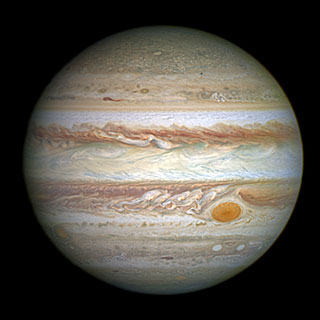The shrinking of Jupiter’s Great Red Spot

PR Image heic1410a Jupiter and its shrunken Great Red Spot
Jupiter's trademark Great Red Spot — a swirling storm feature larger than Earth — is shrinking. This downsizing, which is changing the shape of the spot from an oval into a circle, has been known about since the 1930s, but now these striking new NASA/ESA Hubble Space Telescope images capture the spot at a smaller size than ever before.
Jupiter's Great Red Spot is a churning anticyclonic storm [1]. It shows up in images of the giant planet as a conspicuous deep red eye embedded in swirling layers of pale yellow, orange and white. Winds inside this Jovian storm rage at immense speeds, reaching several hundreds of kilometres per hour.
Historic observations as far back as the late 1800s [2] gauged this turbulent spot to span about 41 000 kilometres at its widest point — wide enough to fit three Earths comfortably side by side. In 1979 and 1980 the NASA Voyager fly-bys measured the spot at a shrunken 23 335 kilometres across. Now, Hubble has spied this feature to be smaller than ever before.
“Recent Hubble Space Telescope observations confirm that the spot is now just under 16 500 kilometres across, the smallest diameter we've ever measured,” said Amy Simon of NASA's Goddard Space Flight Center in Maryland, USA.
Amateur observations starting in 2012 revealed a noticeable increase in the spot's shrinkage rate. The spot's “waistline” is getting smaller by just under 1000 kilometres per year. The cause of this shrinkage is not yet known.
“In our new observations it is apparent that very small eddies are feeding into the storm,” said Simon. “We hypothesised that these may be responsible for the accelerated change by altering the internal dynamics of the Great Red Spot.”
Simon's team plan to study the motions of these eddies, and also the internal dynamics of the spot, to determine how the stormy vortex is fed with or sapped of momentum.
This full-disc image of Jupiter was taken on 21 April 2014 with Hubble's Wide Field Camera 3 (WFC3).
[1] The Great Red Spot is a high-pressure anticyclone. It rotates in an anti-clockwise direction in Jupiter's southern hemisphere.
[2] The Great Red Spot itself may have been mentioned in writings before the late 1800s. There are references to Jupiter's “permanent spot” dating back as far as the late 1600s, although some astronomers disagree that the permanent spot mentioned is the Great Red Spot.
The Hubble Space Telescope is a project of international cooperation between ESA and NASA.
Image credit: NASA, ESA, and A. Simon (GSFC)
Acknowledgement: C. Go
Georgia Bladon
ESA/Hubble, Public Information Officer
Garching bei München, Germany
Tel: +49-89-3200-6855
Email: gbladon@partner.eso.org
Media Contact
All latest news from the category: Physics and Astronomy
This area deals with the fundamental laws and building blocks of nature and how they interact, the properties and the behavior of matter, and research into space and time and their structures.
innovations-report provides in-depth reports and articles on subjects such as astrophysics, laser technologies, nuclear, quantum, particle and solid-state physics, nanotechnologies, planetary research and findings (Mars, Venus) and developments related to the Hubble Telescope.
Newest articles

Superradiant atoms could push the boundaries of how precisely time can be measured
Superradiant atoms can help us measure time more precisely than ever. In a new study, researchers from the University of Copenhagen present a new method for measuring the time interval,…

Ion thermoelectric conversion devices for near room temperature
The electrode sheet of the thermoelectric device consists of ionic hydrogel, which is sandwiched between the electrodes to form, and the Prussian blue on the electrode undergoes a redox reaction…

Zap Energy achieves 37-million-degree temperatures in a compact device
New publication reports record electron temperatures for a small-scale, sheared-flow-stabilized Z-pinch fusion device. In the nine decades since humans first produced fusion reactions, only a few fusion technologies have demonstrated…





















